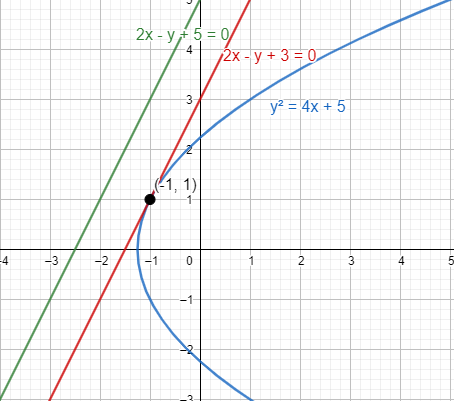Question
Question: A straight line parallel to the line \[2x-y+5=0\] is also a tangent to the curve \[{{y}^{2}}=4x+5\] ...
A straight line parallel to the line 2x−y+5=0 is also a tangent to the curve y2=4x+5 . Then, the point of contact is
A.(2,1)
B.(-1,1)
C.(1,3)
D.(3,4)
E.(-1,2)
Solution
Hint: To solve the question, we have to apply the properties of parallel lines to calculate the tangent line. Thus, the parallel line and the curve have a common point. To calculate the point, apply the formula of slope of line.
Complete step-by-step answer:

We know that the line parallel to the line ax+by+c=0 is ax+by+d=0.
Thus, the line parallel to the line 2x−y+5=0 is 2x−y+d=0
Thus, the line 2x−y+d=0 is tangent to the curve y2=4x+5 .
We know that the slope of line ax+by+c=0 is equal to b−a
On comparing the general equation of line and he tangent line, we get
a = 2, b = -1, c = d
Thus, the slope of line 2x−y+d=0 is equal to −1−2=2 ….. (1)
The slope of tangent to the curve is given by the derivative of the curve.
Thus, we get
dxd(y2)=dxd(4x+5)
We know the formula dxd(xn)=nxn−1,dxd(cf(x))=cdxd(f(x)),dxdc=0 where c is a constant.
By substituting the above formulae, we get
2ydxdy=4dxdx+0
2ydxdy=4
dxdy=2y4=y2
Thus, the slope of tangent to the curve is equal to y2
From equation (1) we get
⇒2=y2
y=22=1
Thus, the value of y = 1
Since the point of contact lie on the curve, on substituting the above value of y we get
12=4x+5
1=4x+5
1−5=4x
−4=4x
x=4−4=−1
Thus, the point of contact of the tangent line and the given curve is (-1,1)
Hence, option (d) is the right choice.
Note: The problem of mistake can be not analysing that the slope of the tangent line is equal to slope of the tangent to the curve. The other possibility of mistake is not being able to apply the formula of differentiation to solve.
